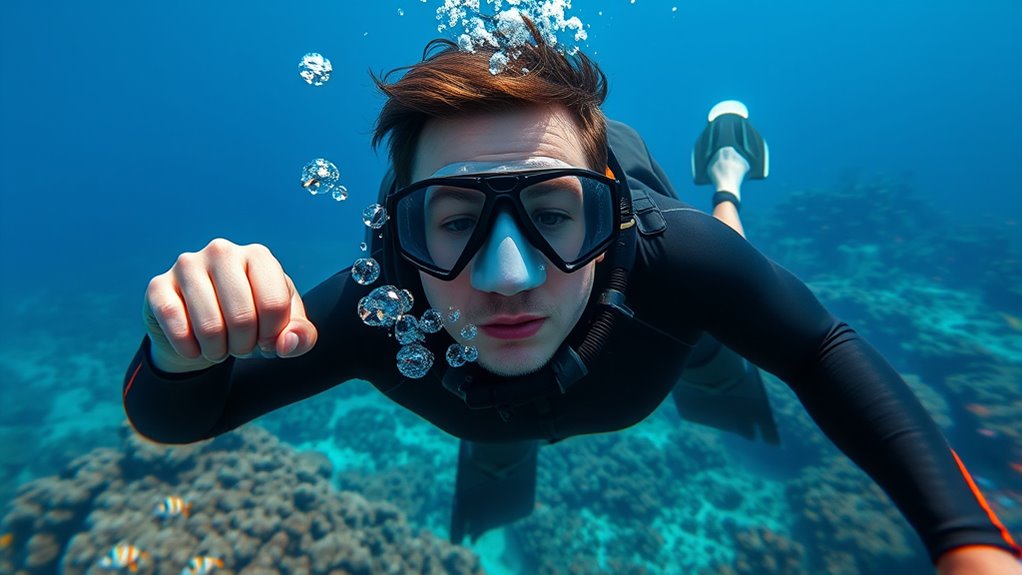To master breath control, focus on slow, steady breathing and deep diaphragmatic breaths to conserve oxygen. Practice lung capacity exercises like max inhale holds over time, and incorporate techniques like box breathing to stay calm. Always listen to your body to avoid discomfort. Regular practice boosts your confidence and underwater endurance. Keep honing these skills, and you’ll discover even more ways to stay relaxed and in control during water adventures.
Key Takeaways
- Practice diaphragmatic breathing to maximize lung capacity and promote relaxation before water activities.
- Use slow, steady breaths underwater to conserve oxygen and reduce panic.
- Incorporate box breathing (4-4-4-4) to enhance mental focus and manage stress during dives.
- Gradually increase breath-hold duration on land to build confidence and lung resilience.
- Maintain awareness of breathing patterns to stay calm and extend your underwater time safely.

When you’re exploring the depths or riding the waves, mastering breath control is essential for staying calm, conserving energy, and extending your time underwater. Whether you’re freediving, snorkeling, or surfing, learning how to manage your breath can substantially enhance your experience. Underwater breathing techniques help you stay relaxed and focused, making each trip more enjoyable and safe. The foundation of good breath control lies in consistent breath hold training, which conditions your lungs and mental state to handle longer periods without air.
Start by practicing breath hold exercises on land to build your capacity gradually. Inhale deeply through your nose, filling your lungs completely, then hold your breath for as long as comfortably possible before exhaling slowly. Repeat this process, aiming to increase your hold time over days and weeks. It’s essential to listen to your body—never push yourself to the point of discomfort or dizziness. Over time, your lung capacity expands, and you develop better control over your breathing patterns, making underwater breathing more natural and less stressful.
Practice breath hold exercises regularly to improve lung capacity and stay relaxed underwater.
When you’re underwater, focus on slow, steady breaths to conserve oxygen and reduce panic. Instead of rapid, shallow breathing, try to breathe deeply from your diaphragm. This not only maximizes oxygen intake but also helps keep your body relaxed. As you practice breath hold training regularly, you’ll notice your ability to stay submerged longer improves. You’ll also find it easier to remain calm in challenging situations, which is critical for safe water adventures.
Incorporating breathing exercises into your routine enhances your lung strength and mental resilience. Techniques like box breathing—inhale for four seconds, hold for four, exhale for four, hold again for four—can be particularly effective. These exercises train your mind and body to stay centered, even when underwater or in turbulent conditions. Consistent practice of breath training can significantly improve your underwater experience by increasing lung capacity and reducing anxiety. The more you practice, the more natural controlling your breath becomes, allowing you to focus on your surroundings instead of your breathing.
Frequently Asked Questions
How Long Can a Water Adventurer Hold Their Breath Underwater?
When it comes to breath hold duration, it varies widely among water adventurers. On average, beginners might hold their breath for 30 seconds to a minute, while trained individuals can reach 2-4 minutes or more. Safety training is vital, as it teaches you how to avoid risks like shallow water blackout. With proper practice, you can improve your breath-hold times safely and confidently, enhancing your overall water experience.
What Are the Risks of Hyperventilating Before Diving?
Imagine hyperventilation as opening a floodgate too wide; it may seem helpful but risks unleashing a tidal wave of danger. When you hyperventilate before diving, you risk panic attacks and lose your natural urge to breathe, making you vulnerable to shallow water blackout. The risks of hyperventilation are serious, potentially leading to unconsciousness underwater. Stay calm, breathe naturally, and respect your body’s signals to guarantee safe adventures.
How Can I Improve My Lung Capacity Safely?
To improve your lung capacity safely, start with gentle lung exercises like diaphragmatic breathing and gradually increase your breath hold training. Practice consistently, but avoid overdoing it to prevent dizziness or hyperventilation. Focus on controlled, deep breaths to expand your lungs effectively. Incorporate breath hold training sessions into your routine, and listen to your body. This approach helps build endurance without risking your health.
Are There Specific Breathing Techniques for Cold Water Diving?
Imagine diving into icy depths—your breath becomes your secret weapon. Yes, specific breathing techniques for cold water diving exist, focusing on controlled breathing patterns to manage shock and conserve oxygen. These methods aid cold water adaptation, helping you stay calm and alert. Practicing slow, deep breaths before and during your dive prepares your body, making each plunge safer and more enjoyable. Mastering these techniques empower confidence in even the coldest waters.
How Does Breath Control Enhance Underwater Safety and Performance?
Breath control boosts your underwater safety and performance by improving lung expansion and oxygen efficiency. When you manage your breathing, you conserve oxygen, reducing the risk of shallow dives or panic. It also helps you stay calm and focused, allowing longer, safer dives. Proper breath techniques enhance your ability to handle sudden situations and extend your time underwater, making your water adventures more enjoyable and secure.
Conclusion
Mastering these breath-control tricks will gently guide you through water adventures with confidence and grace. As you embrace each technique, you’ll find your rhythm and ease flowing naturally, turning challenges into seamless moments. Trust in your growing skills, and let your breath be a quiet anchor amid the waves. With patience and practice, you’ll discover a calm that whispers reassurance, making every splash and surge feel just a little more within your reach.










